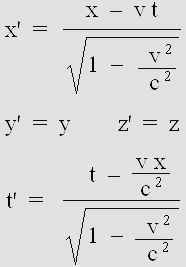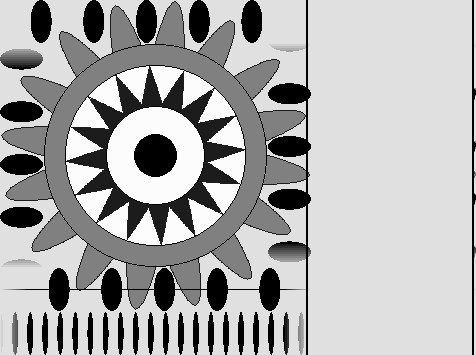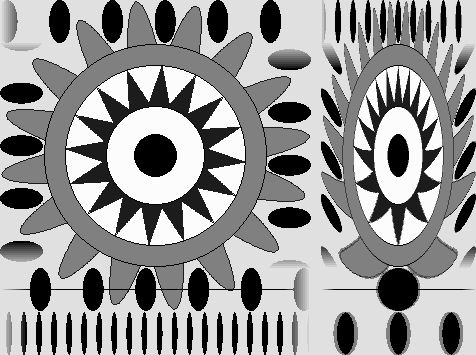|
|
The Time Scanner indicates that the Lorentz transformations are nothing else but a Doppler effect.
They both produce an axial contraction, a slower rate of time and a time shift.
|
The Lorentz transformations. Hendrick Antoon Lorentz discovered that when a material structure is moving very fast: 1 – Distances along the displacement axis contract. 2 – All phenomena occur with a slower rate of time, hence clocks indicate slower hours. 3 – A time shift occurs between the front and the rear. These three transformations take place in accordance with: |

The Lorentz transformations.
|
The previous page on the Lorentz transformations shows that Lorentz's equations can be simplified and reversed like this:
Lorentz's reversed Doppler equations.
1. The print speed ratio. If t = 0, the first equation above simplifies to x' = g x. This means that matter contracts according to Lorentz's g contraction factor. The Time Scanner can achieve the same contraction rate by using a slower speed for printing than for scanning. So
the speed ratio must be 1 : g.
2. The scan and print speed. 2. If t = 0, the second equation above simplifies to t' = –beta * x. This indicates that a time or phase shift occurs along the x axis, and that its value for x = 1 as compared to x = 0 simply equals –beta. The Time Scanner can perform the same time or phase shift by adjusting the scan speed. Firstly, it must scan leftward because the time shift is
negative. Secondly, it must scan a first clock on the right when it
indicates 0
second and end the scanning process on the left where another
synchronized clock indicates exactly "beta" second. So the
time needed for scanning a 1 light second distance is beta and it turns out that the
scan speed must equal 1 / beta in light seconds per second
units; but it can also be in
wavelengths per period units because the beta normalized speed for light
is c = 1.
Scan speed: 1 / beta. Finally, because the print speed must be slower than the scan speed
in accordance with a 1 : g ratio, one obtains the correct print
speed:
Print speed: g / beta Now, let's scan leftward a x = 0 to –1 light second distance using beta = .866 and g = .5:
Scan speed: 1 / .866 = 1.1547 light second per second. Print speed: .5 / .866 = .577 light second per second. This procedure produces a length contraction and a time shift.
The Lorentz transformations are just a Doppler effect. Because the calculus derives from the Lorentz transformations, the printed image in the animation shown above indicates the correct contraction and time shift while scanning two clocks whose distance is one light second. But surprisingly, when the same scanning procedure is applied to regular outgoing spherical waves, the result is a Doppler effect.
The Time Scanner and the Lorentz transformations both produce a Doppler effect.
A slower frequency. In addition, when the scanner line reaches the emitter, the transverse wavelength is the same in the scanned and in the printed images. The point is: this is not the regular Doppler effect, where the unchanged frequency rather produces a transverse wavelength contraction according to Lorentz's g factor. The absence of transverse contraction indicates that the emitter's frequency slows down according to the same factor. This is consistent with Lorentz's original equation set, which indicate that a slower rate of time occurs according to g * t and that there is no transverse contraction: y ' = y z ' = z Surprisingly, the Time Scanner produces this effect spontaneously without any additional intervention. However, it can still produce the normal Doppler effect by adding Voigt's k constant (see previous page). Then it must contract both vertical and horizontal distances according to an additional k = g factor. Actually, any frequency is possible by varying k. Scanning spherical standing waves. One can obtain a picture of my moving electron by scanning regular spherical standing waves. |
|
|
The Time Scanner produces a picture of my moving electron from regular spherical standing waves.
De Broglie pointed out that the time shift produces a phase wave, which becomes visible here.
|
Here is a video showing how the Time Scanner can correct the Doppler effect, the time shift, the time dilation and the contraction according to Lorentz's equations. Amazingly, all this is performed in just one operation. Please note that your AVI Player may take many seconds for downloading the file, so you may prefer right click and save it on your hard disk first: In this video, the Scanner cancels the Doppler effect, so it is consistent with Lorentz's original equations. However, it can also produce a Doppler effect if the scanning direction is reversed. Scanning forward. The forward direction performs the opposite effects. It is possible because the Lorentz transformations are perfectly reversible. Reversing the scan direction reverses the results the same way Henri Poincaré found for Lorentz's equations (see also below). Then the Time Scanner cancels the transformations, hence the Doppler effect, but also the contraction and the phase/time shift. So it produces exactly the same effects as Lorentz's original equations, which purpose was to achieve Maxwell's equations invariance. Here is a video showing this: Below is another video showing better the same phenomenon without the Scanner. Please note that Lorentz's time shift is actually a phase shift which becomes well visible if the emitter is a hoop. So the emission process begins in the rear; it is not simultaneous for a given circular wavefront. This phenomenon is especially amazing. Doppler_Lorentz_2D_standing_waves.avi The phase wave. The time shift produces a phase wave, which was as far as I know discovered by Louis de Broglie and which speed is 1 / beta in the forward direction. It is clearly visible on the right part of the animation below (vertical stripes moving forward). Surprisingly, the scan line follows exactly this phase wave, where the t' time does not change. So it produces a picture where clocks are perfectly synchronized: they indicate the same time everywhere. It turns out that the scan speed is actually that of the phase wave: 1 / beta wavelengths per period. |
|
|
Inversely, scanning my moving electron, one obtains a picture of regular spherical standing waves.
On the one hand, the Time Scanner produces or corrects the Doppler effect.
On the other hand, the same procedure produces or corrects the Lorentz transformations.
This is a flawless proof that the Lorentz transformations are just a Doppler effect.
|
Adjusting the scan and print speed without the help of Lorentz. Using identical scan and print speed, scanning spherical outgoing waves produces a Doppler effect with the well known wavelength forward vs. backward R ratio: R = (1 + beta) / (1 – beta) The results for different velocities easily indicate that the scan speed is 1 / beta. Then one also realizes that, using identical scan and print speed, scanning spherical outgoing waves produces elongated elliptical waves. The distortion according to different velocities appears to be equivalent to Lorentz's g factor. So, in order to obtain perfectly spherical waves, it becomes obvious that the print speed should be slowed down according to g. Around 1900, this factor was called "the aberration" (see Poincare's text below) and it was discovered well before 1887 by Michelson. Clearly, the Time Scanner can reveal the correct contraction value for the Lorentz transformations without the help of Lorentz and Poincare. They apparently could find it because local hours were involved. So they looked for a special value of Voigt's constant which would make it impossible for an observer to detect his absolute motion. This happened for Michelson's experiment, Bradley's stellar aberration, Fizeau experiment, etc., and they tried to generalize it for any physical phenomenon. This means that in 1895 they were already aware of Relativity, albeit their perception of it was unclear until 1904. The Time Scanner can handle more complex systems. The Time Scanner can also show the way many objects moving at different speeds and along different axes would be transformed if their frame of reference was accelerated, slowed down, stopped and even accelerated in the opposite direction. On the contrary, the Lorentz transformations can handle only one object at a time and it cannot accelerate or decelerate it from a given speed to another one. It should also be emphasized that the relativistic law of speed addition was worded by Henri Poincare in his 1901 "Electricity and optics" book, well before Einstein did. Because the Time Scanner never produces faster than light speeds, it also perfectly handles the relativistic law of speed addition. So it can accelerate the moving gear below again and again and it will never reach the speed of light. |

Here, a system at rest (on the left) is accelerated to 0.866 c.

Here is how an accelerated rotating wheel and its different gear systems would look like.
The Time Scanner also performs the law of speed addition, where the speed of light is never attained.
Lorentz's equations cannot handle so many transformations simultaneously.
Even worse, Einstein's Relativity leads to many paradoxes, not to say contradictions.
For example, Ehrenfest's paradox is no longer relevant here because moving matter contracts, not space.
|
MR. SERGE CABALA'S ANIMATIONS Here is the link to Mr. Cabala's French page: http://members.aol.com/scabala25/ There is a very interesting animation there showing a piston machine with its fly wheel. It seems distorted in a rather strange way, but it is correct because the Time Scanner would also produce this result. This indicates that Mr. Cabala has fully understood the Lorentz transformations. By 1975, he was the first person on this planet to speak about matter's unique wave nature. He also showed that Lorentz's Relativity is consistent with aether.
RULING OUT ELECTROMAGNETIC WAVES Woldemar Voigt showed in 1887 that the Doppler effect could be cancelled using a transformation equation set very similar to Lorentz's. Voigt, Lorentz and Poincaré were all using Maxwell's equations. So most scientists linked the Lorentz transformations to any electromagnetic phenomena. In addition, Poincare rejected Lorentz's theory about matter contraction. As soon as 1901, in his book "Electricity and Optics", he pointed out that it looked much like a strange "coup de pouce", (a helping hand) from nature. This did not satisfy him. His own idea was that optical phenomena behave according to the relative motion of matter in presence. There is no preferred frame of reference any more. This is clearly identical to Einstein's 1905 Special Relativity and it should be emphasized that it was published in 1901.
Poincare's famous "coup de pouce" from in his 1901 book.
However, scientists should realize today that matter really contracts because it exhibits wave properties. There is no "coup de pouce" any more. Let's be clear: Poincaré was wrong. He was a fantastic mathematician, but one can nevertheless find in his works many surprising, indeed disputable thoughts about physics. It is also a well known fact that Einstein was well aware of Poincare's ideas from 1901 to 1905. In spite of that, he wrote his own 1905 paper without any reference to him and "his" theory finally triumphed. All physicists in radio-electricity know that Maxwell's equations lead to unbelievable complex calculus. Poincare's 1901 book is especially exhaustive. However, it turns out that Maxwell's equations are totally useless here. The scanner procedure shows that the Lorentz transformations also work with regular waves, not just with Maxwell's equations. The Lorentz transformations are simply linked to the Doppler effect. This is of the utmost importance. My page on standing waves shows that they undergo the Lorentz transformations. This seems to have been discovered by Mr. Yuri Ivanov. He also used this property to explain matter transformation, but unfortunately he used his own Ivanov's transformations (1981) which coincide with Michelson's incorrect calculus. Mr. Ivanov nevertheless performed two significant, indeed brilliant steps towards the truth. The rest of his work about "rhythmodynamics" and antigravity appears rather weird, though. Matter transforms because it acts and reacts using waves. Such interactions and forces also undergo the Doppler effect. So they must also undergo the Lorentz transformations, and this leads to Relativity. On the one hand, matter waves and force waves should transform the way Lorentz discovered. On the second hand, Relativity is definitely true and it involves the Lorentz transformations. One should draw the following conclusion: |
|
Relativity strongly indicates that matter is made of waves. |
| 01 | 02 | 03 | 04 | 05 | 06 | 07 | 08 | You are here. | 10 | 11 | 12 | 13 | 14 | 15 | 16 |
| 17 | 18 | 19 | 20 | 21 | 22 | 23 | 24 | 25 | 26 | 27 | 28 | 29 | 30 | 31 | 32 | 33 |
|
Gabriel LaFreniere, Bois-des-Filion in Québec. absolu2000@hotmail.com On the Internet since September 2002. Last update December 6, 2007. |